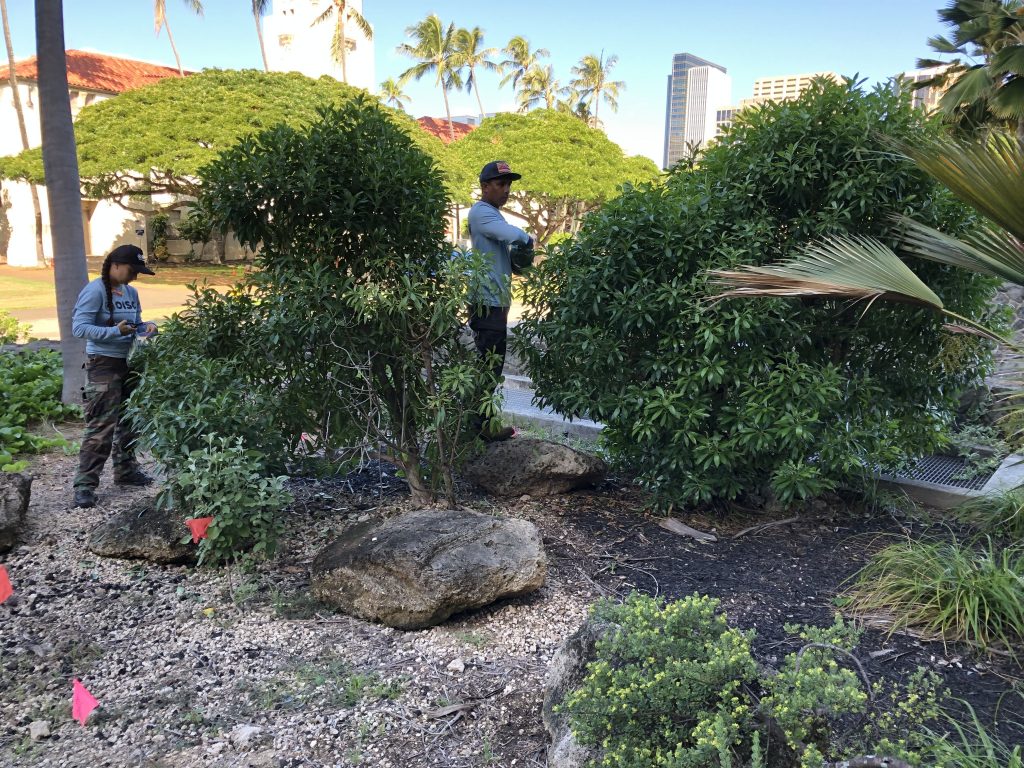10/02/19-NAIO THRIPS ATTACK KALANIMOKU NATIVE GARDEN
Posted on Oct 2, 2019 in Forestry & Wildlife, HISC, Invasive Species, Main, News Releases, sliderNews Release
| DAVID Y. IGE GOVERNOR |
SUZANNE D. CASE
CHAIRPERSON |
For Immediate News Release: October 2, 2019
NAIO THRIPS ATTACK KALANIMOKU NATIVE GARDEN
To view video please click on photo or view at this link: https://vimeo.com/359147895
(Honolulu)- One of Hawaii’s most important native plants is the Naio tree. Naio has been widely planted in landscapes and is an important component of our island’s coastal ecosystems. A decade ago naio became threatened with a small invasive insect pest known as thrips found on Hawai’i Island. Thrips are narrow, dark brown to black and approximately 2.2.5 mm in size and are native to Tasmania. They were likely first accidentally introduced in the U.S. in California.
Thrips have also been found on Oʻahu and they threaten the overall survival of naio in the wild. Thrips attack naio by sucking tissue out of new leaves. With no known, natural predators, they thrive and feed so heavily on plants, that they stop producing new leaves and eventually die.
Pesticide treatments have not been effective at completely removing thrips from naio landscape and there are no effective pesticides for treatment in natural areas.
Thrips were recently discovered at the State Kalanimoku Building native garden. They’ve been removed by O’ahu Invasive Species Committee (OISC) staff. The crew clipped off the infested ends, removed entire plants and transported them to H-Power to be burned. A few months ago, thrips were also discovered in DLNR Chair Suzanne Case’s yard.
Landscaped naio will provide a jumping off point for these insects and help them spread to important wild spaces like Kaʻena Point, the Kaiwi Shoreline, the National Wildlife Refuge at Kalaeloa and the offshore islets. Removing infected landscape naio is the best way to preserve Oʻahu’s wild naio for future generations.
On Hawai’i Island, where naio was an important part of the dry mid-elevation forest, surveys were not able to find 10 healthy trees in the Puʻu Waʻawaʻa forest a decade after the thrips were accidentally introduced there. One conservationist on the Big Island likened the destructive ability of these insects to wildfire.
If you would like to help monitor naio trees, you can sign up for the Adopt-a-Naio Program. “So, if you drive past a naio plant or if you have a naio plant in your yard, you can help us by monitoring that plant. What you should look for is curling of the leaves at the end of the plant,” said Erin Bishop OISC Outreach Specialist.
If you inform OISC of your infected naio tree, they will help replace it. “OISC can provide aʻaliʻi or hao as a replacement if you have infected naio,” said Bishop.
Media contacts:
AJ McWhorter
Giovonni Parks
Communications Specialists
Hawaii Department of Land and Natural Resources
[email protected]
808-587-0396 (Communications Office)
Erin Bishop, Outreach Specialist for OISC
[email protected]
808-266-7994
www.oahuisc.org
